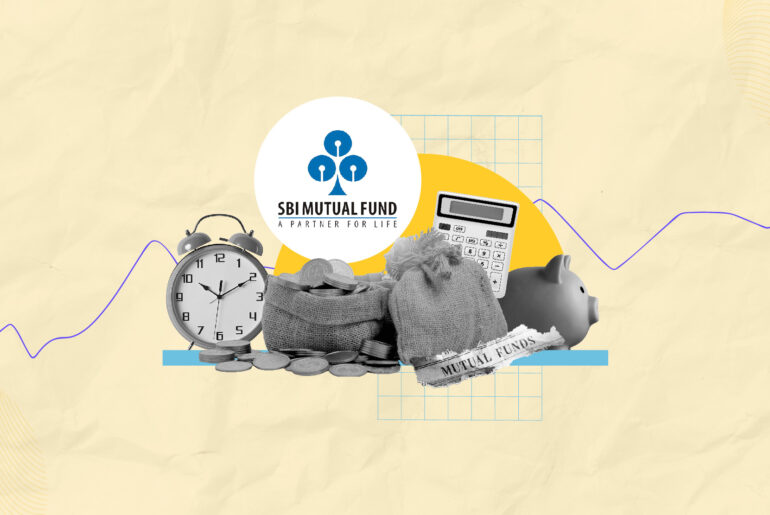Last Updated on May 24, 2022 by Aradhana Gotur
Mutual funds are professionally managed schemes that pool the investment of different investors and then invest it in different securities. The portfolio of a mutual fund scheme is often diversified and it may consist of even different assets, not just different stocks. Each asset has a different value and so, the per-unit cost of the portfolio is determined using the Net Asset Value, or NAV. Let’s understand what NAV means.
Table of Contents
What is NAV in mutual funds?
NAV full form is Net Asset Value. It represents the per-unit price of a mutual fund or ETF scheme. Since the portfolios of these schemes are diversified, NAV assesses the average market price of each unit of the security held in the portfolio. NAV is used to determine how many units you would get when you invest in a mutual fund scheme. Similarly, when you exit the mutual fund scheme, the NAV is used to determine the number of units redeemed.
Calculation of NAV
The calculation of NAV is quite simple. The aggregate market value of the portfolio is divided by the number of units to get the NAV. The liabilities and the expenses incurred are deducted from the value of the portfolio before dividing it with the number of securities. The NAV formula is as follows:
NAV = [current market value of the portfolio – (liabilities + expenses)] / number of units of outstanding securities
Let’s understand with an example.
Suppose 100 investors invest Rs 10,000 each in a mutual fund scheme. The total corpus amounts to Rs 10 lakh. Now the fund manager invests the corpus as follows (assuming the liabilities and expenses to be nil):
| 200 units of Security A at Rs 1,500 each | Rs 1,50,000 |
| 300 units of Security B at Rs 2,000 each | Rs 4,00,000 |
| 300 units of Security C at Rs 1,500 each | Rs 4,50,000 |
| Total corpus | Rs 10,00,000 |
800 units have been bought with a corpus of Rs 10 lakh. So, the mutual fund NAV per unit would be calculated as follows:
NAV = 10 lakh / 800 = Rs 1,250/unit
Now, if you invest Rs 50,000 and the NAV of the mutual fund is Rs 1,250/unit, you would get 40 units.
Features of NAV
Here are some of the salient features of NAV:
The NAV value is a dynamic figure. It changes with the change in the market value of the underlying assets. When the fund manager buys and sells securities in order to capture potential growth, the value of the total securities changes. This also affects the NAV of the mutual fund scheme
The purchase and redemption of units are done at the applicable NAV
Mutual funds are required to declare their daily NAVs every day
The NAV of mutual funds also shows the returns yielded by the scheme. If the NAV grows, it means that the portfolio of the scheme is also growing and that the scheme is generating returns. On the other hand, when the NAV falls, it signals a loss
NAVs are applicable only in the case of pooled investment schemes. So, when you come across NAV, mutual fund or ETF would be the likely avenue for the same, since these schemes have an underlying diversified portfolio
NAV and investment timing
The timing of your investment is very important in determining which day’s NAV value would be applicable when calculating the number of units that you would get. As per SEBI’s latest rule, from 1st Feb 2021, the application of NAV would depend on when your investment is credited to AMC’s bank account. The cut-off timing for NAV applicability has been fixed at 3:00 PM, both when investing and when redeeming from the mutual fund scheme.
For example, say you invest Rs 1 lakh in a mutual fund scheme. You make the transaction at 2:00 PM and the funds get credited in the AMC’s bank account at 2:30 PM. Supposing the NAV for the day is Rs 100. In this case, you would get 1000 units (1,00,000/100).
If, however, the transaction happens after 3:00 PM, NAV of the next day would be applicable. If the next day’s NAV is Rs 105, the number of units that you would get would be 952.38.
In the case of liquid and overnight mutual funds, with values exceeding Rs 2 lakh, the timings are different. In the case of investment, the cut-off time for NAV application is 1:30 PM and for redemption, it is 3:00 PM.
NAV vs market price – the difference
Many investors consider NAV to be the market price of securities. This is wrong. The NAV and the market price are two different concepts that have completely different implications. Here’s how:
Market price
The market price is used to denote the value of a single type of asset. It is influenced by the demand and supply of the asset and its market perceptions.
NAV
NAV depicts the per-unit market value of a diversified portfolio of assets. It is determined by the market value of each asset held by the portfolio as well as the number of securities that the fund has. NAV is affected by the liabilities that the fund has and its expenses and it is calculated daily by the fund manager.
It's a wrong notion that many investors consider NAV to be the market price of securities. Whereas the NAV and the marketplace are two completely different concepts. Click To TweetUsing NAV to assess mutual fund performance
When comparing mutual fund schemes, the NAV of the scheme does not give the right picture of the scheme’s performance. While it remains that the higher the growth in NAV, the higher the returns earned from the fund, a scheme with a higher NAV might not necessarily be better than a similar scheme with a lower NAV. The lower NAV of a scheme might be due to the high diversification of the scheme’s portfolio. So, comparing mutual fund schemes solely based on their NAVs is not the right approach. You should, instead, compare the schemes based on their historical returns, consistency, and portfolio composition.
Know what is NAV in a mutual fund to understand NAV meaning and how it is calculated to understand how the per-unit cost of a mutual fund or ETF scheme is determined. Also, keep the cut-off timings in mind when investing in mutual fund schemes to know which day’s NAV would be applicable in allotting units. When investing, compare the funds based on their returns, not NAVs, and then select a scheme.
- Top Fund of Funds (FOF) in India – Full Form, Types & More - Mar 28, 2025
- Bond Funds – Meaning, Types, Risks, and Benefits - Mar 27, 2025
- Money Market Mutual Funds: Meaning, Benefits, Liquidity and Taxation - Mar 13, 2025




